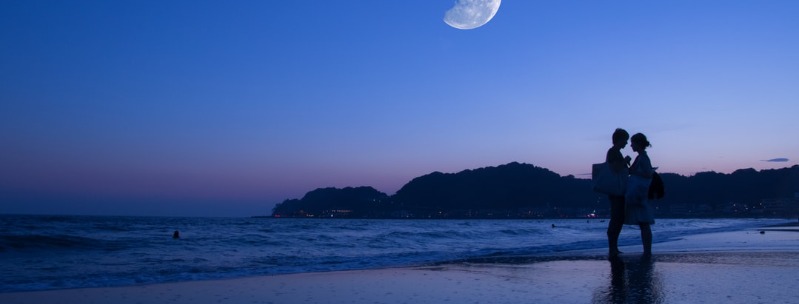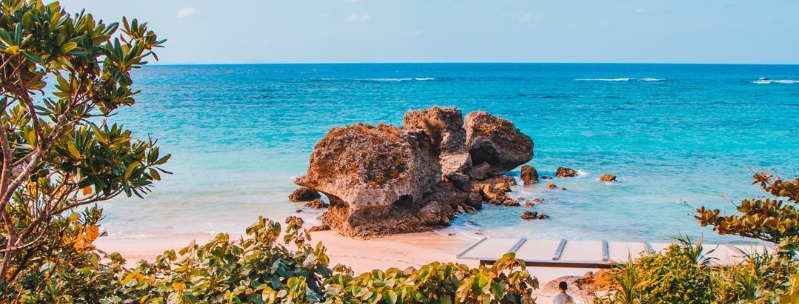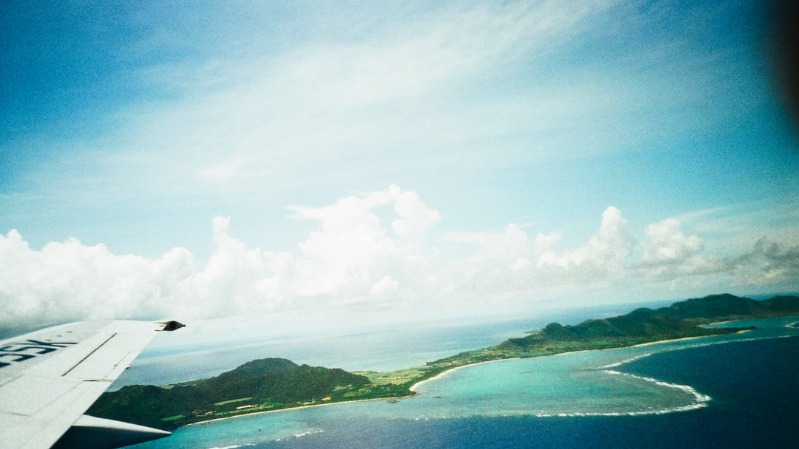Best Japan Beach Destinations 2024
As Japan is an archipelago, you’d be forgiven for thinking that it is blessed with some pleasant beaches.
The truth is that industrialization has blighted much of the coastline and that many of the decent beaches are covered with litter and/or polluted.
The best beaches are those furthest away from the main island of Honshu, which means those on the islands of Okinawa south of Kyushu, or the Izu and Ogasawara islands south of Tokyo.
Kamakura
A small, relaxed town trapped between the sea and a circle of wooded hills one hour’s train ride south of Tokyo, Kamakura is steeped in history.

Many of its 65 temples and 19 shrines were founded some eight centuries ago, when, for a brief and tumultuous period, this was Japan’s political and military center. Its most famous sight is the Daibutsu , a glorious bronze Buddha surrounded by trees, but the town’s ancient Zen temples are equally compelling.
Kamakura lies at the coast of the Pacific Ocean. Large beaches are located just about 10 minutes from Kamakura Station by foot. The beaches are very popular during the hot summer months when they are crowded not only with locals but also with visitors from the close Tokyo/Yokohama area.
Kerama Islands
Lying some 30km offshore, the Kerama Islands are the closest group to Naha. A knot of three large, inhabited islands and numerous pinpricks of sand and coral, the Keramas offer some of the most beautiful and unspoiled beaches in Okinawa and superb diving among the offshore reefs.
Tokashiki-jima, the largest island and the closest to Naha, attracts the greatest number of tourists, but all the islands are surprisingly quiet outside the summer peak (July & Aug). This might not last much longer. Already Zamami-jima, the most interesting of the group, and nearby Aka-jima are busy upgrading their ports, hotels and roads. Much of this has been spurred by the recent boom in whale-watching during the winter months.

A frolicking whale statue greets ferries pulling in to Zamami-jima ‘s new harbor, behind which lies tiny Zamami village , the only settlement of any size on the island, with 700 inhabitants out of a total population of 1000. They speak their own dialect and maintain a fierce rivalry with the much larger Tokashiki-jima a couple of kilometers away to the east.
A fine place to get away from it all, Zamami-jima has spectacular beaches, both on the island itself or a short boat ride away. You can dive year-round, but the best time to visit is in autumn, when most tourists have gone and while the water is still warm enough for swimming and snorkeling.
With a good pair of binos you can often spot humpbacks spouting and cavorting off Zamami’s north coast. There’s a special whale observatory about 3.5km northwest of Zamami village, one of several look-out points scattered round the cliffs and on the island’s highest peak, Takatsuki-yama. Even allowing for stops it only takes a couple of hours to explore every road on Zamami, after which there’s nothing for it but to head to the beach.
Roughly 1km southeast of the village, Furuzamami beach is the best on the island, with excellent coral and troops of multicoloured fish. In season, you can rent snorkels at the small shop and there’s also a restaurant and showers. However, the beaches get even better on the tiny, offshore islands, such as Gahi-jima and Agenashiku-jima, just south of Zamami. In summer (June to mid-Sept) small boats take day-trippers out to these islands for a small fee, but out of season you’ll have to charter your own boat.
Miyako Islands
There’s a gap of nearly 300km between Okinawa-Honto and the eight Miyako Islands centered around Miyako-jima, the largest and most interesting of the group. In late April, you’ll find Miyako swarming with athletes competing in the All-Japan Triathlon, a combination of swimming, cycling and running, and in July the Miyako Matsuri, the island’s main festival, runs for three days, but otherwise the prime attractions are pretty coastal scenery, quiet beaches and watersports.

A flat triangular-shaped island, roughly 35km from tip to tip and just 12km at its widest point, the most immediately notable aspect of Miyako-jima is its extensive cultivation of sugar cane. Hirara, the main town, lies on the island’s northwest coast, from where roads fan out through the fields.
Hirara has its own beach, Painagama, immediately south of the harbor, but there are much better ones around the island. Top of the list is Maehama , around 10km south of Hirara, a long and remarkably pristine strip of soft white sand that is hailed as Japan’s best beach.
The next beach of note is Boraga, reached by a steep twisting road from Route 390. It’s a good spot for snorkelling and kayaking and equipment for both is available from the attractive beachside complex that includes a refreshment hut and a freshwater swimming pool.
Heading north up the east side of the island, duck off the coastal road to find the quiet beaches at Aragusuki and Yoshino, both excellent snorkeling spots with corals and a plethora of tropical fish.
After this there’s little to linger for until you reach the bridge at the far north of the island which connects Miyako with tiny Ikema-jima. Ikema has a lazy fishing port and more deserted beaches and good coral reefs, including the extensive Yaebishi reef exposed annually during the low spring tides.
On the way back to Hirara you may well want to pause for yet another lovely beach, Sunayama, 2.5km north of the town. You’ll need to climb over several dunes to reach the sea, and it’s a good spot to come for sunset which you can view through a naturally eroded stone arch.
Okinawa Beaches
The prefecture of Okinawa comprises more than one hundred islands, stretching over 700km of ocean from Kyushu southwest to Yonaguni-jima, almost within sight of Taiwan. Collectively known as the Ryukyu Shoto, this chain of subtropical islands, with their lush vegetation, paradise beaches and superb coral reefs, has become a popular destination for Japanese holiday-makers and foreign residents alike.

Few other tourists make it down here, partly because of the time and cost involved, but if you’ve had your fill of shrines and temples, want to check out some of Japan’s best beaches and dive sites , or simply fancy a spot of winter sun, then Okinawa is well worth considering.
There are three popular beaches on the west side of Okinawa Island. They are called Moon beach, Manza beach, and Okuma beach. Manza beach is the most popular. It is about a one and a half hour drive from Naha-city. Don’t miss the view of Monza-mou, which is a famous cliff made of coral reef. The beaches of Okinawa Island are open from April to October.
The beaches on Okinawa’s main island can’t compare with the gems lying offshore among the dozens of outer islands that make up the rest of the prefecture. Here, you’ll find not only superb, white sands and limpid water, but also magnificent diving – both skin and scuba – which is among the best in Asia .
Yaeyama Islands
Edging ever closer to the Tropic of Cancer, a further 100km southwest of Miyako-jima and 430km south of Okinawa-Honto, is a cluster of coral reefs and forested mountains which make up the Yaeyama Islands . The main base for exploring the nine inhabited islands is Ishigaki-jima, though you can also stay on nearby Iriomote-jima, famous for its wild, wooded interior and unique wildlife population, or the delightful Taketomi-jima where a traditional Ryukyu way of life is most in evidence. Stuck out on its own, around 100km west of Ishikagi-jima, Yonaguni-jima marks Japan’s most westerly point, from where it’s only another 125km to Taiwan. As with the Miyako Islands, the main reason for coming here is the spectacular diving and snorkelling opportunities, although trekkers and kayakers will also be inspired by the forest trails, rivers and indented coastline of Iriomote.
Brooding darkly some 20km west of Ishigaki, Iriomote-jima is an extraordinarily wild place for Japan. Rising sharply out of the ocean, its uncharted, mountainous interior, some ninety percent covered with dense subtropical rainforest, harbours a unique population of wildlife including one of the world’s rarest species, the yamaneko or Iriomote lynx.
Although it’s Okinawa’s second largest island with an area of 284.5 square kilometers, less than 2000 people live here, most of them concentrated along a barely developed strip on the northeast coast
Iriomote is, naturally, a divers’ paradise, with the Manta Way between the island’s eastern coast and Kohama-jima being particularly famous for its shoals of manta rays; you’re most likely to sight them between April and June. The youth hostels and all minshuku will be able to put you in touch with the island’s several dive operations. Snorkelling is particularly good at Hoshizuna beach, around 4km northwest of Funaura, where you’ll also find a campsite, decent restaurant and snorkelling gear for rent. There’s also a lovely, remote beach at Funauki, reached by three ferries a day from Shirahama, at the far west end of the coastal road.
The third largest island in the Ryukyu chain, Ishigaki-jima is also the administrative centre of the Yaeyama Islands. Named after the stone walls that surround the islands’ traditional residences, some eighty percent of the Yaeyamas’ population lives here, yet outside of the main town Ishigaki, located on the southwest coast, it’s a predominantly rural and mountainous landscape, dominated by the prefecture’s tallest peak, Omoto-dake (526m) and fringed with rocky peninsulas, stunning beaches and easily accessible reefs. Indeed, flying into Ishigaki’s decidedly homely airport you feel more like you’ve arrived in some South Seas banana republic rather than the last outpost of one of the wealthiest nations on earth. This could well change if the authorities ever manage to overcome long-standing local opposition to the construction of a new airport – the current proposed location would destroy a precious reef.
North of Kabira you’ll find a couple of resort hotels around the horseshoe-shaped Sukuji beach and, facing back towards Kabira Bay, exclusive Club Med Kabira. They’ve also hogged one of the best beaches on the island, although it’s still possible to access this beautifully sandy strip, if you’re not a guest, by taking an off-road track closer to Kabira.
Many people make the ten-minute ferry crossing from Ishigaki to Taketomi-jima; indeed, this flat island – just 1500m at its widest point and home to less than 300 people – gets inundated with day-trippers eager to see its traditional houses, ride on its buffalo-drawn carts and search lovely sandy beaches for the famous minuscule star-shaped shells.
If you’ve really got time on your hands, or a burning desire to get to the far reaches of Japan, the Yaeyama group includes several more islands to plan your itinerary around. Hateruma-jima , 56km from Ishigaki, marks Japan’s southernmost point and sports beautiful Nishi beach. Kohama-jima, 18km west of Ishigaki, is home to the ritzy Haimurubushi Resort. Both of these are served by regular ferries, but if you want to get to tiny Hatoma-jima, north of Iriomote, or Aragusku-jima, 24km southwest of Ishigaki, you’ll need to charter a boat.
